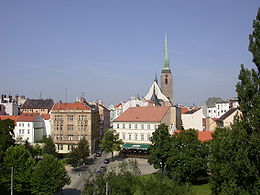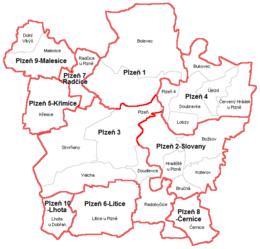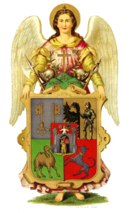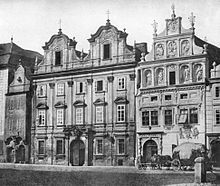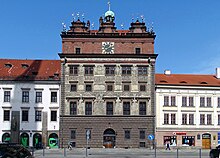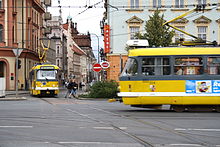Pilsen
| Plzeň | ||||
|---|---|---|---|---|
|
||||
| Basic data | ||||
| State : |
|
|||
| Historical part of the country : | Bohemia | |||
| Region : | Plzeňský kraj | |||
| District : | Plzeň-město | |||
| Area : | 13765 ha | |||
| Geographic location : | 49 ° 44 ' N , 13 ° 23' E | |||
| Height: | 308 m nm | |||
| Residents : | 172,441 (Jan 1, 2019) | |||
| Postal code : | 301 00 | |||
| License plate : | P (old: PM, PN) | |||
| traffic | ||||
| Railway connection: |
160 Plzeň – Žatec 170 Praha– Plzeň –Cheb 180 Plzeň – Furth im Wald 183 Plzeň – Železná Ruda 190 Plzeň – Č. Budějovice |
|||
| structure | ||||
| Status: | Statutory city | |||
| Districts: | 10 boroughs 31 districts |
|||
| administration | ||||
| Lord Mayor : | Martin Zrzavecký (as of 2014) | |||
| Address: | náměstí Republiky 1 306 32 Plzeň |
|||
| Municipality number: | 554791 | |||
| Website : | www.plzen.eu | |||
Pilsen ( Czech Plzeň , ˈpl̩.zɛɲ ) is the fourth largest city in the Czech Republic in the west of Bohemia and the administrative seat of the Pilsen Region ( Plzeňský kraj ). Pilsen is best known for its Pilsner beer and the Škoda factory . The university and diocese city has around 170,000 inhabitants and has an important position as an industrial, commercial, cultural and administrative center. In 2015 Pilsen was - together with the city of Mons in Belgium - European Capital of Culture .
geography
Climate and geography
Pilsen is located in the Pilsen Basin at the confluence of the rivers Mies , Radbusa , Úhlava and Úslava . The České Údolí dam is located on the south-western outskirts of the city . The city center is around 310 m nm. Some hills within the city area reach up to 452 m nm. The old town stands on Arkoseuntergrund . Pilsen belongs to the cool temperate zone with long, dry summers, warmer transitional periods and very dry winters with a short duration of snow cover. The annual average temperature is 7.5 ° C, the average annual precipitation around 520 mm. The highest measured temperature was 40.1 ° C (1983, Pilsen-Bolevec) and the lowest -27.6 ° C (1987, Pilsen-Bolevec). The duration of sunshine varies between 1400 and 1700 hours a year.
City structure
The city of Plzeň is divided into 10 municipal districts , to which 31 districts belong.
- Plzeň 1: Bolevec (Bolewetz) and Severní Předměstí
- Plzeň 2-Slovany: Božkov (Boschkau), Černice (Tschernitz, Czernicz), Doudlevce , Hradiště (Hradischt), Koterov (Kotterau), Lobzy (Lobes) and Východní Předměstí
- Plzeň 3: Doudlevce (Doudlewetz, Daudlewetz), Jižní Předměstí , Litice (Lititz), Nová Hospoda , Radobyčice (Radobschitz), Skvrňany , Valcha , Vnitřní Město and Východní Předměstí
- Plzeň 4: Bukovec (Bukowetz), Červený Hrádek , Doubravka (Dobraken), Lobzy , Újezd (Aujest) and Východní Předměstí
- Plzeň 5-Křimice: Křimice (Krimitz)
- Plzeň 6-Litice: Litice
- Plzeň 7-Radčice: Radčice (Radschitz)
- Plzeň 8-Černice: Černice
- Plzeň 9-Malesice: Dolní Vlkýš and Malesice
- Plzeň 10-Lhota: Lhota
population
For the second half of the 14th century, the city's population is estimated at 3,000. The Thirty Years' War also brought many deaths and a massive decline in the population. In the middle of the 19th century the number of inhabitants exceeded the ten thousand mark. In the following years, Pilsen developed into one of the most important industrial locations in Austria-Hungary , and the population grew by leaps and bounds. Already in 1890 the city had over 50,000 inhabitants, then in the thirties 100,000 citizens and since the turn the population has fluctuated around 170,000.
| year | 1869 | 1880 | 1890 | 1900 | 1910 | 1921 | 1930 | 1950 | 1961 | 1970 | 1980 | 1991 | 2000 | 2001 | 2002 | 2003 | 2004 | 2005 | 2006 | 2007 | 2008 | 2009 | 2010 | 2011 |
|---|---|---|---|---|---|---|---|---|---|---|---|---|---|---|---|---|---|---|---|---|---|---|---|---|
| population | 23,681 | 38,883 | 50,221 | 68,079 | 80,445 | 88,416 | 114,704 | 124,339 | 132,799 | 148.021 | 170.701 | 173.008 | 166,759 | 164,336 | 163,791 | 164.180 | 162,627 | 162,759 | 163.392 | 165.238 | 169.273 | 169.935 | 168,808 | 167,302 |
history
City foundation
Old Pilsen was founded in the 10th century as an economic and administrative center of the Přemyslids in western Bohemia. In the Latin sources this city appears as Pilsna , the origin of the name is controversial. Neu-Pilsen was founded around 1295 by locator Heinrich and on behalf of King Wenceslaus II as a royal city . The city should become one of the largest and most important Bohemian cities, so it was laid out very generously. The main market with the dimensions of 139 × 193 m is one of the largest marketplaces in Europe and the street width was unusual for medieval conditions. The town plan was measured regularly and consists of rectangular blocks of houses. Pilsen was allocated the largest land area after Prague . In 1300, Pilsen was specifically mentioned for the first time in a document from Basel Bishop Peter von Aspelt . Although the city was the youngest royal city in Western Bohemia, it quickly developed into the region's political and economic center.
From an economic and geographical point of view, the city was laid out on the trade route from Prague , which in Pilsen divided into branches that ran to Nuremberg (the most important long-distance trade route in Bohemia in the Middle Ages), Regensburg and Eger . The most important export item is cattle up to the 16th century, which the townspeople of Pilsen bought from all over Bohemia or even in Upper Hungary (today's Slovakia ) and mainly exported to Bavaria . After 1400, 46 different crafts were mentioned in Pilsen.
Reformation and Hussite Wars
In 1417 there was a coup in Pilsen and the supporters of the Hussites took over city posts. Pilsen became the center of radical, chiliastic Hussiteism. In 1419 radical Hussite supporters left Prague and moved to Pilsen, so the city became the center of the movement. In addition to the radical priest Václav Koranda , Jan Žižka was one of the city's most important personalities. The town was blocked by the West Bohemian Catholic nobility and in various scuffles, Žižka scored a first victory in the battle of Nekmíř in 1419 .
The overall situation of the Hussite city became more and more difficult and in 1420 the radical part of the Hussites left it. Pilsen then changed sides and became an integral part of royal power and Catholicism . The Hussites were unsuccessful. The worst attempt was the siege of the city from July 1433 to May 1434. In January 1434 the Pilseners succeeded in a counter-attack to capture a camel as a trophy. This event became part of the city's coat of arms from the 1460s. In the spring of 1434 the town was supplied with food by the former Taborite captain and defector Přibík von Klenová (allegedly delivered in a total of 120 wagons). At the beginning of May the siege was abandoned and the Hussite troops withdrew. In the following wars the city changed sides several times.
“In the Middle Ages, the German population was still relatively high - but that changed under the influence of state rule. Many Germans changed languages, and for this reason many Pilseners still have very German-sounding surnames today. "
In 1468 the printing technique was first used in Pilsen in Bohemia .
Thirty Years' War
During a plague epidemic in Prague, Emperor Rudolf II moved briefly to Pilsen with his court in 1599–1600 . The emperor later decided to build an annex in Pilsen and had the "Imperial House" built in Pilsen in 1606, which he never used.
The Thirty Years War meant for Pilsen from the very beginning a fall into poverty and huge debts. After the outbreak of the class uprising in 1618, Pilsen remained loyal to the emperor. On November 21, 1618, after a brief siege, the city was captured by an army of the estates under Ernst von Mansfeld and occupied with devastating consequences until April 1621. During this time the city served as the main base and main source of income for the army.
From 1631 Pilsen was the base of an imperial army, which was assigned to protect the city from a Saxon army from Bavaria . The imperial army offered protection, but its accommodation and food put a heavy burden on the city economically and led to large debts. At the end of the war and for some time afterwards, Swedish armies marched through the city area several times.
After the Thirty Years War, the urban economy was ruined, the suburbs burned down, the urban population decimated, and a third of the town houses in the inner city were devastated. The repair of the damage and the economic reconstruction took almost a century. Long-distance trade relations sank to a minimum. Social life suffered general decline. Only at the end of the 18th century did the population return to pre-war levels. Pilsen then remained a provincial town of no great importance until the 19th century.
In 1840 the “dominant language” of the inhabitants was “Bohemian, but there are many in the city who are familiar with German”.
Industrial age
In the second half of the 19th century, Pilsen was again in second place in Bohemia after Prague in terms of size and importance. In 1869, the most important mechanical engineering company, Škoda, was established in the following years . The second largest plant of this time after 1898 was the railway works of the state railways with around 2,000 employees. It was the largest repair shop in Austria-Hungary . The Pilsen railway junction was completed between 1861 and 1877. The first tram line operated in Pilsen in 1899.
In 1900 the German-speaking population, which has been declining since modern times, was only 13.5 percent.
Despite this economic boom, the living and hygienic conditions were poor, especially for the Pilsen workers . From 1911 to 1919, Škoda tried to remedy these conditions by building the workers' housing estate in Karlov. Overall, however, residential construction activities remained inadequate. The Škoda works began to specialize more and more in armaments and in later years became the largest arms manufacturer in Austria-Hungary. Pilsen delivered heaviest artillery pieces such as the 30.5-cm M.11 mortar , which in the First World War was used. In 1917 32,000 workers worked at Škoda. On May 25, 1917, around 300 people were killed in an explosion in the munitions factory in the Pilsen suburb of Bolevec. In the following twenty years, the industrial city of Pilsen with the neighboring mining area was an important economic center of the Czechoslovak Republic, founded in 1918 .
Before the occupation by the German Reich from 1939 to 1945, around 3,200 Jews (less than 125,000 inhabitants) lived in Pilsen (1938). 3,000 of them were deported in three transports to Theresienstadt and other concentration and extermination camps in January 1942 .
From 1939 to 1945 the arms industry in Pilsen worked for the German Reich. Therefore were in the Second World War, the Škoda Works target of air raids, first the Royal Air Force, and later the US Air Force. On May 5, 1945, an uprising of local resistance broke out in the city , but the Germans took action. On May 6th, units of the 16th US Armored Division and the 2nd US Infantry Division of the 3rd US Army liberated Pilsen. At the same time, thousands of soldiers of the Wehrmacht and Waffen-SS surrendered in and around the city in order to avoid being captured by the Red Army . At the end of November 1945, the US troops withdrew again. The German population of the city was expelled from 1945 .
On June 1, 1953, a currency reform caused serious unrest in the city. 20,000 people, mainly workers from the Škoda works, demonstrated against the communist regime. Protesters broke into the town hall and threw communist symbols, furniture and other items from the windows. In the afternoon, the demonstration was violently ended by the state authorities.
On August 21, 1968, the entry of Soviet troops into Pilsen ended the Prague Spring .
politics
The following parliamentary groups are represented in the municipal council of the statutory city (zastupitelstvo statutárního města): ODS : 14 seats, ČSSD : 14 seats, TOP 09 : 7 seats, KSČM : 5 seats, OBČANÉ.CZ: 5 seats, Pravá volba per Plzeň: 2 seats . The distribution of seats is the result of the local elections from October 15 to October 16, 2010. The turnout was 39.44 percent.
Mayor before 1989
- Martin Kopetzky, 1840
List of Lord Mayors (since 1989)
- Stanislav Loukota, March 2, 1990 - December 5, 1990
- Zdeněk Mraček ( OF ), 1990-1994
- Zdeněk Prosek ( ODS ), 1994-1998
- Jiří Šneberger ( ODS ), 1998-2004
- Miroslav Kalous ( ODS ), 2004–2006
- Pavel Rödl ( ODS ), 2006–2010
- Martin Baxa ( ODS ), 2010-2014
- Martin Zrzavecký ( ČSSD ), since 2014
Town twinning
Pilsen is twinned with the following cities:
education
The public school system is represented by 29 elementary schools , 5 grammar schools and 18 specialist grammar schools . There are two university institutions in Pilsen. The smaller one is the Medical Faculty in Pilsen, part of the Charles University in Prague with around 1400 students. The younger and larger university is the University of West Bohemia in Pilsen with around 17,200 enrolled students (as of autumn 2006). The Czech office of the Coordination Center for German-Czech Youth Exchange Tandem is located in Pilsen .
Diocese
Since May 31, 1993, Pilsen has been the seat of the Roman Catholic Diocese of Pilsen. The first incumbent was Bishop František Radkovský . Tomáš Holub has been the second bishop of Pilsen since April 2016 . The diocese covers almost the entire area of Plzeňský kraj (the southern part remained with the Bishopric of Budweis ) and Karlovarský kraj with a total of 818,700 inhabitants (of which 149,000 are Catholics). The diocese church is St. Bartholomew's Cathedral on Republic Square in Pilsen. The diocese is divided into 10 vicariates with a total of 72 parishes .
Economy and Infrastructure
Key figures
The unemployment was 31 March 2017 3.12%
Companies
Parts of the Škoda Group are still located in the city, focusing on heavy machinery, power plant construction (including nuclear power plants) and rail vehicle technology. The Škoda companies are the largest employers in the city and the region. The brewery and spirits industry, represented by Pilsner Urquell AG and the spirits manufacturer Stock Plzeň-Božkov, plays an important role .
An extraordinary project is the construction of the Borská pole industrial park from 1996. In December 2005, 42 companies were based here with a total of 9790 jobs, mainly in the fields of electrical engineering, automotive components and (light) mechanical engineering. The industrial park won first, second and third places in the competition for the industrial area of the year. In this industrial park is u. a. the production facility for Panasonic flat screens. Another industrial area is being developed in the renovated complex of the former Škoda Group near the city center. The Pilsen Research and Technology Park, which is currently under construction, is worth mentioning.
Škoda
The mechanical engineering company Škoda was economical and formative for Pilsen in terms of the cityscape. The plant was founded in 1859 by Count Ernst von Waldstein and bought in 1869 by the engineer Emil von Škoda . This modernized the company. Škoda manufactured sugar factories, breweries and steam engines. Later the company focused more and more on the arms industry. From 1886 gun turrets for battleships were manufactured in Pilsen . During the First World War, the plant then became the largest arms manufacturer in the Habsburg monarchy Austria-Hungary with around 32,000 workers in 1917.
After the war ended, locomotives were the first to be manufactured. In the following years, Škoda built sugar factories, mills, breweries, power plants, mines and slaughterhouses all over the world. In 1925, the company took over the automobile manufacturer Laurin & Klement , today Škoda Auto .
After the Second World War, the main plant in Pilsen focused primarily on heavy industry, initially steam and later electric locomotives, turbines and power plants. Turnkey industrial plants were still being built abroad. A civil nuclear program began in Pilsen in the 1950s. After the turnaround in 1989, the group was privatized and divided into individual areas. At the moment, several independent companies bear the name Škoda, they are still the largest employers in the city.
Breweries
Due to the originally very poor beer quality, the citizens of Pilsen, who had the right to brew beer, decided in the middle of the 19th century to build a new brewery in order to create the technical prerequisites for the production of a more modern, bottom-fermented beer. In spring 1842 they appointed the Bavarian Josef Groll as the first master brewer . He is known as the originator of the world-famous so-called Pilsner brewing method. The bourgeois brewery was constantly expanded in the following years; by the end of the century it already employed around 600 people. In 1898 the trademark Pilsner Urquell was registered. From 1874, the brewery exported its beer to the United States. In 1912 she owned 336 railway wagons of her own. In 1913/1914 annual production exceeded 1 million hectoliters for the first time.
In addition to the Bürgerliches Brauhaus , the first Pilsener Aktienbrauerei was established in 1869 with the still existing Gambrinus brand , which was initially used as the brewery name for its beer. After the Second World War, both breweries were nationalized and merged under the name of Pilsener Breweries . 1992–1994 the state-owned enterprise was privatized and was named Plzeňský Prazdroj as (German: Pilsner Urquell AG ). The company has been part of the South African Breweries plc group since 1999, and SABMiller since 2004 .
traffic
Local public transport
In 1899 the first electrified tram line was put into operation in Pilsen (today's line 4). There are currently three lines in the city.
- Line 1 (Bolevec – city center – Slovany)
- Line 2 (Skvrňany – city center – Světovar)
- Line 4 (Košutka – city center – Bory)
Trolleybuses have been running in Pilsen since 1941 , currently with 9 lines (no. 10-18). There are also around 25 bus routes. Night traffic is guaranteed with three special bus routes (N1, N2, N3). The urban area is united in a transport association (Integrovaná doprava Plzeňska).
Streets
Motorways:
- D5 Prague –Pilsen– Rozvadov / Waidhaus with the connection to the German A6 and with a city bypass around Pilsen
European roads:
- E49 ( Magdeburg ) - Plauen - Cheb - Karlsbad - Pilsen - Budweis - ( Vienna )
- E50 ( France ) - Nuremberg - Pilsen - Prague - Brno - ( Slovakia , Russia )
- E53 Pilsen– Deggendorf - ( Munich )
railroad
The main railway connection runs from east (Prague) to west (Cheb / Nuremberg). Two pairs of trains of the SuperCity express train run on this route every day .
- Route no. 170 east / west (east-west connection) (Prague) - Beroun –Pilsen– Marienbad –Cheb (on to Nuremberg)
- Route No. 190 (to the southeast) Pilsen - Budweis
- Route no. 160 (north) Pilsen - Žatec
- Route no. 180 (to the southwest) Pilsen - Domažlice - Furth im Wald . (continue via Schwandorf to Munich or Nuremberg). This is the most important connection to Germany. Four pairs of trains in the Czech Republic declared as EuroCity are operated by alex .
- Route No. 183 (to the south) Pilsen - Klatovy - Železná Ruda / Bayerisch Eisenstein
Air traffic
The closest airport for long-distance travelers is Prague Airport (approx. 60 minutes by motorway). Nuremberg Airport, 210 kilometers away, and Munich Airport, 280 kilometers away, are easily accessible . One of the smaller airports is Karlovy Vary Airport, 75 kilometers away . Southwest of Pilsen is the former military airfield, today the non-public international airfield Pilsen-Líně with a 1450 m × 60 m runway and VFR regime. The Pilsen-Letkov (ICAO: LKPL) sports airfield with a 700 m long grass-covered runway is located southeast of Pilsen.
Culture
The historic city center was declared an urban monument reserve in 1989 .
European Capital of Culture 2015
On September 8, 2010, Pilsen prevailed in the domestic Czech competition against Ostrava for the 2015 European Capital of Culture . The 2015 program comprised over 50 shows and 600 events, it officially began with the opening ceremony on January 17, 2015. On the occasion of this title, the international competition for young dancers of the EBU, Eurovision Young Dancers 2015 , was held in Pilsen.
architecture
The most dominant building in the city is the St. Bartholomew Cathedral , which was first documented shortly after the city was founded. It is a mighty Gothic, three-aisled building with the late Gothic Sternberg Chapel and a 102.26 m high square tower. The tower is the tallest church tower in Bohemia and the dominant part of the city of Pilsen. The tour for visitors is at a height of 62 m. In good weather, the Bohemian Forest 70 km away can be seen.
The Pilsen town hall was built by Giovanni de Statio in the years 1554–1559 in the Renaissance style. The plague column erected in 1691 is located between the town hall and the cathedral . The Great Synagogue is Europe's second largest synagogue from the 19th century (after that in Budapest ). The building was completed in 1893 in a Moorish-Romanesque style. Numerous Art Nouveau buildings are worth mentioning . There are some interiors by Adolf Loos in Pilsen . The old town is a listed building .
Theaters and stages
The first theater building was built in 1832 in what is now Rieger-Strasse. The German citizens of the city built a German theater on Goethe-Strasse in 1869 - the Small Theater . The Small Theater closed its doors in 1966 and the building was demolished in 1977. Today the largest theater in Pilsen has the Josef Kajetán Tyl Theater , a drama, opera, ballet, operetta and musical ensemble with several stages. Today's Great Theater was built in 1899–1902 and the Chamber Theater opened in 1965. In 1980 performances began in the Theater im Klub , the third stage of the Tyl Theater. Finally, in 2014, the New Theater was completed and opened as part of the European Capital of Culture 2015 .
Smaller theaters such as the Pluto Cabaret Theater and the Dialog Theater , a small scene for numerous amateur theater groups, are an integral part of the Pilsen theater world . The terminal building of the Pilsen-Süd station, which is no longer used for tourist traffic, serves as an alternative stage.
Puppet theater and puppet shows have a long tradition in Pilsen. Between 1930 and 1943 the first professional puppet theater in Czechoslovakia by Josef Skupa (creator of Spejbl and Hurvínek ) moved to Prague after the Second World War. After that, a professional puppet theater was not established again until 1966. At first it only bore the popular name and later officially the name of the building "Alfa". The theater has co-organized the Skupova Plzeň festival since 1967. The amateur puppet theater V boudě has existed since 1928 - with an involuntary interruption from 1939 to 1946. Since 1991 the puppet theater association V boudě has been sponsor.
Museums
The West Bohemian Museum in Pilsen is an institution of the Plzeňský kraj and is one of the most important museum institutions in the region. An important part of everyday museum life is dedicated to research. The museum has 10 departments: Folklore , Modern History , Prehistory , Middle Ages , Paleontology , Botany , Zoology , Restoration , Department for Archaeological Rescue Excavations and the Museum of Handicrafts . There are currently four permanent exhibitions in the main building: the armory , a collection of Meissen porcelain, archeology of the Pilsen region and regional history. There is an outsourced exhibition room nearby: Masné Krámy, a medieval meat market from 1392. After several restorations, temporary exhibitions are shown here and concerts are held regularly.
Branches are the Folklore Museum and the Puppet Museum on the Republic Square, the "Diocese Museum" in the former Franciscan monastery with a permanent exhibition of Christian objects of fine art and the Dr. Šimon Adler Museum in Hartmanice with an exhibition on the history of the Jewish population West Bohemia.
The Brewery Museum was established in 1959 as part of the West Bohemian Museum. In 1987 it was handed over to the state-owned Pilsen Brewery and is now owned by the Pilsen Urquell Brewery . The museum has a permanent exhibition on the history of beer, its production and related crafts. In 2008, the Škoda Holding and the University of West Bohemia in Pilsen opened the Regional Technical Museum “ Techmania ” . The Old Synagogue houses a permanent exhibition on Jewish culture. A private book printing museum was opened on Plovární Street in 2015 .
Libraries
The largest library in the city is the Scientific Library of the Pilsen Region, built in 1950 with a total of 1,734,327 media (as of 2005). The library of the city of Pilsen , founded in 1876, today has around 400,000 volumes. The University Library of the University of West Bohemia in Pilsen has a total of 365,232 media (as of 2005). The smallest facility is the library of the West Bohemian Museum, founded in 1880, with around 70,000 media.
Historic cellars
The Pilsen historical cellars are an extensive complex of underground rooms and corridors that extend under the entire old town. Originally there were medieval merchants' cellars and numerous fountains. These were connected to one another from the 1970s and today serve as the groundwater drainage system for the old town. Some of the rooms are accessible to visitors. The tour includes the early modern urban waterworks, a historical sewage tunnel and several exhibits on the history of the urban water supply .
Zoological and Botanical Gardens
The zoological and botanical garden of the city of Pilsen is located on a 21 hectare, richly structured area in the Lochotín district. Around 1,100 taxa of various animal species are represented in 6,000 specimens. The zoo participates in European conservation breeding programs for 23 animal species . The zoological garden was founded in 1926. In 1957 the botanical garden , which was independent until 1981, was added.
Events
The following cultural events take place regularly:
| month | Born in 2015 |
Surname | description |
|---|---|---|---|
| February March | 35. | Smetana days | International classical music festival |
| April | 28. | Finále Plzeň | Festival of Czech and Slovak full evening films and documentaries |
| April | Predator Run | Extreme obstacle course | |
| June | 31. | Skupova Plzeň | Marionette theater festival |
| September | 23. | Festivaldivadlo | International theater festival |
| May | Liberation Festival | Festival commemorating the liberation of the city by US forces and the end of World War II |
|
| October | Pilsen festival | Festival of Pilsner beers - Pilsner Urquell and Gambrinus. |
Personalities
Well-known personalities of the city are included in the list of personalities of the city of Pilsen .
etymology
For the etymology of the city name many exist folk etymology explanations and several of the more conservative literature. Even on the question of whether the name is of Germanic or Slavic origin, there is no agreement, also due to the complex, overlapping settlement of Germanic and Slavic tribes. The classic of Czech place names, Antonín Profous, deals with the origin of the name of Plzeň in some detail and gives three classic, Czech-language explanations: first, derived from the adjective “plzký” - which means slippery / slippery (the city was laid out on slippery, damp ground ); second, derived from “plž”, which means snail in German (there were many snails in the area); third, derived from the adj. "plzný" = "useful, fruitful". Pollmer also writes on the subject that the place name goes back to the Czech word plzni (useful, pleasant). Another widespread explanatory model calls this mhd. Bilsen / Pilsen (modern rushes ) as the namesake for the city, as it was founded on a rush- lined bank. Rätsch states that the name of the city goes back to henbane ("Pilsner Kraut") and is related to beer production. Ironically, the “Pilsner Kraut”, which does not conform to the Purity Law, was the eponymous godfather of the most common non-henbane beer, the Pilsner .
literature
- I. Martinovský: Dějiny Plzně v datech . Nakladatelství Lidové noviny, Prague 2004, ISBN 80-7106-723-7 .
- D. Bechný: Historie a současnost podnikání na Plzeňsku . Městské knihy, Žehušice 2002, ISBN 80-86699-01-3 .
- Viktor Velek: Pilsen. In: Oesterreichisches Musiklexikon . Online edition, Vienna 2002 ff., ISBN 3-7001-3077-5 ; Print edition: Volume 4, Verlag der Österreichischen Akademie der Wissenschaften, Vienna 2005, ISBN 3-7001-3046-5 .
- Tobias Weger: Pilsen / Plzeň. Small town history , Pustet, Regensburg 2015, ISBN 978-3-7917-2656-4 .
Web links
- Official information server of the city of Pilsen (German, Czech, English)
- Association of Germans in Bohemia - Pilsen Region
Individual evidence
- ↑ Český statistický úřad - The population of the Czech municipalities as of January 1, 2019 (PDF; 7.4 MiB)
- ↑ Český statistický úřad ( Memento from July 16, 2012 in the web archive archive.today )
- ↑ radio.cz
- ↑ Six things you did not know about Pilsen | Radio Prague . ( radio.cz [accessed January 7, 2018]).
- ↑ Historical map from 1627 Outline of Pilsen instead of how they were besieged and stormed in Anno 1619 as ( digital copy )
- ^ Johann Gottfried Sommer: The Kingdom of Bohemia: Bd. Pilsner Kreis . Pilsner Kreis, No. 6 . JG Calve, Prague 1838, p. 9 ( google.at [accessed on January 7, 2018]).
- ↑ KK Central Statistical Commission (ed.): Community encyclopedia of the kingdoms and countries represented in the Reichsrat . Edited on the basis of the results of the census of December 31, 1900. Böhme, no. IX . Alfred Hölder, Vienna 1904, p. 598 .
- ↑ Article on the Liberation of the City by Radio Praha
- ↑ Informační server Magistrátu města Plzně: Partnerská města ( Memento from October 9, 2012 in the Internet Archive )
- ^ Official website of the city of Gera
- ↑ Základní informace o kraji. Retrieved September 2, 2017 (cz).
- ↑ Pilsen celebrates: In 2015, guests will be welcomed as the European Capital of Culture
- ↑ Pilsen 2015 - a city joins in ( memento from February 23, 2015 in the Internet Archive ). Travel EXCLUSIV magazine website, accessed September 16, 2014.
- ↑ Traditional events
- ↑ Smetanovske Dny
- ↑ Festival Finale ( Memento from April 17, 2015 in the Internet Archive )
- ↑ youtube.com
- ↑ Skupas Pilsen International ( Memento from July 14, 2014 in the Internet Archive )
- ↑ Festivaldivadlo
- ↑ From Normandy up to Pilsen: Liberation Festival Pilsen
- ↑ A. Profous: Místní jména v Čechách. Praha 1951, pp. 382-384.
- ↑ Andrea Fock, Jutta Muth, Udo Pollmer , Monika Niehaus : Opium for the people: Natural drugs in our food. (books.google.de)
- ↑ Bilsen / Pilsen. In: Beate Hennig: Small Middle High German Dictionary. (books.google.de)
- ^ Christian Rätsch : Urbock or real beer. July 29, 2015, accessed on August 26, 2015 : “ These former plantings live on in various place names to this day, z. B. Bilsensee, Billendorf, Bilsengarten and especially in the Bohemian Pilsen. The city, after which our modern, heavily hopped beer is called »Pilsner«, takes its name from the henbane, which gave the real »Pilsener beer«, namely the henbane beer, its name! In Switzerland the old name pilsener krut lives on in the name Pilsenkraut to this day. "


